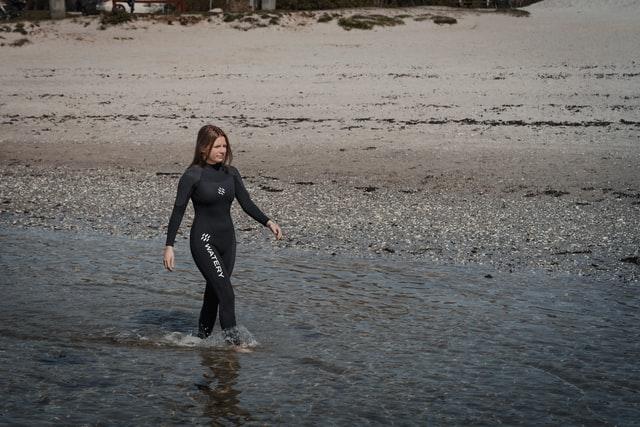Wetsuit Thickness and Temperature Guide (With Chart)
Whether you are a diver, swimmer, or surfer, chances are you need a wetsuit. Water temperatures vary around the globe during the year, and sometimes it can be downright uncomfortable to get in the water without one. But this brings up the question, just what type of wetsuit do you need?
Wetsuits come in different types as well as thicknesses and the one you need will depend on the temperature of the ocean where you live as well as the activities you plan to engage in. Keep reading to find out what type of wetsuit is best for you.
Wetsuit Thickness Guide By Temperature
If you know the temperature of the ocean you swim or dive in, then picking a wetsuit may be as easy as taking a quick peek at the wetsuit temperature chart below.
What Should You Consider When Choosing a Wetsuit?
As you can see, the ocean temperature is the main deciding factor to take into account when choosing a wetsuit. The wetsuit temp guide above is not the only thing you should take into account, however, as there are many other factors that will affect the thickness of wetsuit you need.
For example, if you are prone to getting cold quickly, the last thing you want to be doing is shivering while trying to ride a wave. Therefore you should go up a thickness level in wetsuit to keep yourself comfortable.
Additionally, you should consider factors like your exposure to the wind, the wind speed, how active you will be, and the outside air temperature. Although the wetsuit is designed to keep you warm in the water, it should also keep you warm as you come out of the water as well. If you are doing a rigorous activity that will make you sweat, then you may not need as thick of a wetsuit as the chart above recommends.
Not sure what wetsuit is right for you? It’s best to take a look at manufacturer recommendations and speak to someone who has experience with wetsuits before you buy.
Why Does Wetsuit Thickness Matter?
It may seem easier just to pick the thickest wetsuit on the list and be good in all temperatures. This, however, is incorrect, as the thicker the wetsuit gets, the more you begin to sacrifice flexibility. If you are a surfer, you need much more flexibility than a diver who is spending time moving slowly underwater.
Remember, wetsuits are designed to keep the warmth in, meaning they will also keep in the sweat and could cause you to overheat when you are being especially active. But on the other end of the spectrum, choosing a wetsuit thickness that is too thin could put you at the risk of hypothermia, which is a dangerous condition when you are out in ocean waters.

Wetsuit Thickness Types (Chart)
When purchasing a wetsuit, it’s important to know a little more about the wetsuit before you buy besides just the thickness. For example, from the chart above you may know that you want a 3mm wetsuit, but when you head to the store you only see a 3/2mm wetsuit. What does the second number mean?
Despite what you may think, this number is not a fraction, rather it is an indication that the body portion of the wetsuit is 3mm, while the legs are 2mm. This gives an athlete more flexibility while keeping the most important organs warm.
The wetsuit thickness chart below will give you a better idea of what each thickness indicates.
What is Summer Wetsuit Thickness?
Sometimes you may hear someone tell you that you need a summer wetsuit. This means that you need a wetsuit that is under 3mm thick. From there the choice is up to you. If you get cold easily, 2mm wetsuit thickness is recommended, if you don’t, grab a 1mm wetsuit and head for the water.
What is Winter Wetsuit Thickness?
When someone says you need a winter wetsuit, expect it to be cold. A winter wetsuit is anything from 3mm-8mm thick. Before you pick one out, keep the activity you will be performing in mind.
For example, if you are surfing, 3-4mm is what you will need to keep warm while maintaining your range of motion. If you are going diving, however, take a look at the water temperature of the location where you are headed to choose an appropriate wetsuit thickness.

How Should a Wetsuit Fit?
As you are shopping for wetsuits, you may be wondering how they fit. In general, they should fit like a second skin. There should be no areas where the wetsuit is baggy or bunching on you as this can cause chafing and additional water to seep in. Your wetsuit should also be tight around your neck.
While the wetsuit should be tight, you should also still be able to move. Before you walk out of the store with a wetsuit, try it on. Then squat down and make motions with your arms. If you can’t do this, the suit is too tight.
For comfort reasons, most people choose to wear a basic swimsuit beneath their wetsuit. Most women choose a sporty one piece, while men tend to wear a speedo.
Wetsuit Temperature FAQs:
3mm Wetsuit Temperature Limits:
With a 3mm wetsuit you should be warm in temperatures as low as 58°F or 14°C. You may get too hot, however, in temperatures above 68°F or 20°C.
5mm Wetsuit Temperature Limits:
A 55mm wetsuit is quite thick and you should stay warm in temperatures as low as 43°F or 6°C. You will get hot quickly, however, if the temperature is above 58° or 14°. Also, note that your range of motion may be too limited for activities like surfing.
7mm Wetsuit Temperature Limits
A 7mm wetsuit is very thick. This wetsuit is typically only for diving and will keep you warm in temperatures below 40° or 4°C. If you are still cold, then you may want to try an 8/7mm suit or a dry suit.
Link/Reference This Article
If you found the information in this article useful in your research, please link to use as the source using the tool below.
-
<a href="http://seatemperatures.net/blog/wetsuit-thickness-and-temperature-guide/">Wetsuit Thickness and Temperature Guide (With Chart)</a>
-
"Wetsuit Thickness and Temperature Guide (With Chart)". SeaTemperatures.net. Accessed on April 26, 2024. http://seatemperatures.net/blog/wetsuit-thickness-and-temperature-guide/.
-
"Wetsuit Thickness and Temperature Guide (With Chart)". SeaTemperatures.net, http://seatemperatures.net/blog/wetsuit-thickness-and-temperature-guide/. Accessed 26 April, 2024
-
Wetsuit Thickness and Temperature Guide (With Chart). SeaTemperatures.net. Retrieved from http://seatemperatures.net/blog/wetsuit-thickness-and-temperature-guide/.
